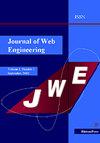Research on Deep Learning and Feature Aggregation Techniques for Web Security
IF 1
4区 计算机科学
Q4 COMPUTER SCIENCE, SOFTWARE ENGINEERING
引用次数: 0
Abstract
With the rapid development of internet technologies, Web services have been widely applied in various fields, including finance, healthcare, education, ecommerce, and the Internet of Things, bringing great convenience to humanity. However, Web security threats have become increasingly severe, with side-channel attacks (SCA) emerging as a covert and highly dangerous attack method. SCAs exploit non-explicit information, such as network traffic patterns and response times, to steal sensitive user data, posing serious threats to user privacy and system security. Traditional detection methods primarily rely on rule-based feature engineering and statistical analysis, but these methods show significant limitations in terms of detection performance when dealing with complex attack patterns and high-dimensional, large-scale network traffic data. To address these issues, this paper proposes a side-channel leakage detection method based on SSA-ResNet-SAN. The SSA (sparrow search algorithm) is an optimization mechanism, intelligently searching for globally optimal feature subsets to enhance the model's feature selection capabilities and global optimization performance. Combined with deep residual networks (ResNet) and the signature aggregation network (SAN), the method performs a comprehensive analysis of both single-attribute and aggregated-attribute features in network traffic, thereby improving the model's accuracy and robustness. Experimental results demonstrate that SSA-ResNet-SAN significantly outperforms existing methods on multiple practical datasets. On the Google dataset, the use of aggregated attribute features enables SSA-ResNet-SAN to achieve an accuracy of 93%, which is substantially higher than that of other models. Furthermore, in multi-class tasks on the Baidu and Bing datasets, SSA-ResNet-SAN exhibits strong robustness and applicability. These experimental results fully validate the outstanding performance of SSA-ResNet-SAN in side-channel leakage detection, providing an efficient and reliable solution for the field of Web security.面向Web安全的深度学习与特征聚合技术研究
随着互联网技术的飞速发展,Web服务已经广泛应用于金融、医疗、教育、电子商务、物联网等各个领域,给人类带来了极大的便利。然而,Web安全威胁变得越来越严重,侧通道攻击(SCA)成为一种隐蔽且高度危险的攻击方法。sca利用非显式信息(如网络流量模式和响应时间)窃取敏感用户数据,对用户隐私和系统安全构成严重威胁。传统的检测方法主要依赖于基于规则的特征工程和统计分析,但这些方法在处理复杂的攻击模式和高维、大规模的网络流量数据时,在检测性能方面存在明显的局限性。针对这些问题,本文提出了一种基于SSA-ResNet-SAN的侧通道泄漏检测方法。SSA (sparrow search algorithm)是一种优化机制,通过智能搜索全局最优特征子集来增强模型的特征选择能力和全局优化性能。该方法结合深度残留网络(ResNet)和特征聚合网络(SAN),对网络流量中的单属性和聚合属性特征进行综合分析,提高了模型的准确性和鲁棒性。实验结果表明,SSA-ResNet-SAN在多个实际数据集上显著优于现有方法。在谷歌数据集上,使用聚合属性特征使SSA-ResNet-SAN的准确率达到93%,大大高于其他模型。此外,在百度和Bing数据集上的多类任务中,SSA-ResNet-SAN表现出较强的鲁棒性和适用性。这些实验结果充分验证了SSA-ResNet-SAN在侧信道泄漏检测方面的卓越性能,为Web安全领域提供了高效可靠的解决方案。
本文章由计算机程序翻译,如有差异,请以英文原文为准。
求助全文
约1分钟内获得全文
求助全文
来源期刊

Journal of Web Engineering
工程技术-计算机:理论方法
CiteScore
1.80
自引率
12.50%
发文量
62
审稿时长
9 months
期刊介绍:
The World Wide Web and its associated technologies have become a major implementation and delivery platform for a large variety of applications, ranging from simple institutional information Web sites to sophisticated supply-chain management systems, financial applications, e-government, distance learning, and entertainment, among others. Such applications, in addition to their intrinsic functionality, also exhibit the more complex behavior of distributed applications.
 求助内容:
求助内容: 应助结果提醒方式:
应助结果提醒方式:


